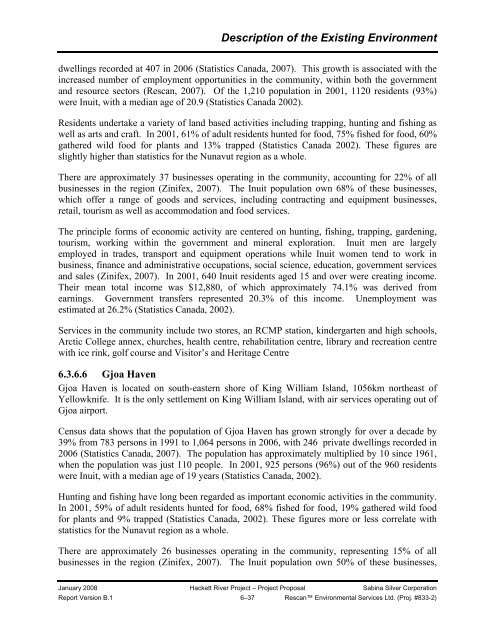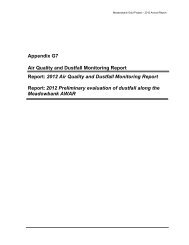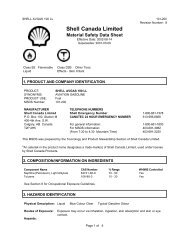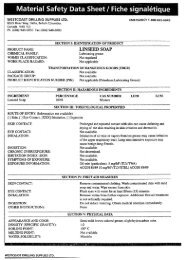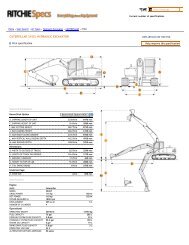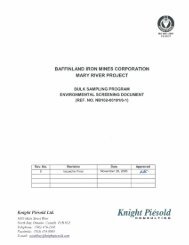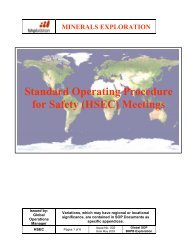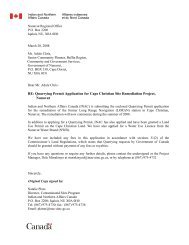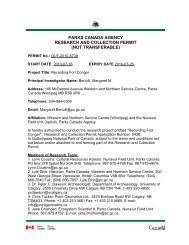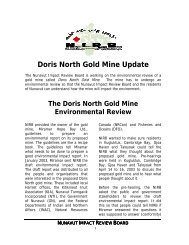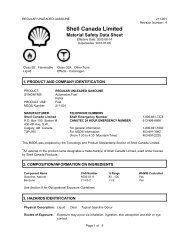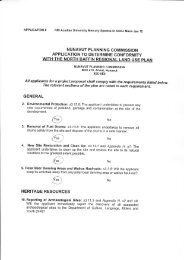Description of the Existing Environment6.3.6.4 Cambridge BayCambridge Bay is situated on the southeast coast of Victoria Island in western Nunavut, 960 kmnortheast of Yellowknife and 1,600 km west of Iqaluit. Cambridge Bay is the largest communityin the Kitikmeot region, acting as a regional transport hub and home to the regional government.Census data for 2006 recorded the total population in Cambridge Bay at 1,477 persons which isup 12.8% from 1,116 persons in 1991, with 524 private dwellings documented in 2006 (StatisticsCanada, 2007). The community has exhibited growth over recent years, excluding the periodbetween 1996 and 2001, during which time population figures marginally decreased (-3.1%) inresponse to the government’s decentralization policy. In 2001, 1,035 residents (79%) out of1,309 person population were Inuit, with a median age of 21.3 (Statistics Canada, 2002).Cambridge Bay is a traditional hunting and fishing location with a number of archaeologicalremnants. Residents undertake harvesting activities which include hunting caribou and fishingArctic char, which are staple local foods. In 2001, 50% of adult residents hunted for food, 68%fished for food and 13.5% gathered wild food for plants (Statistics Canada, 2002). Thesefigures, which are slightly lower than statistics for the Nunavut region as a whole, hint at thegrowing relevance of the diversified modern economy within the community.There are approximately 70 businesses operating in the community, making up 40% of allbusinesses in the region (Wolfden Resources, 2006). The Inuit population own 56% of thesebusinesses, which offer a range of goods and services, many of which are supported by themining industry. Tourism is also an important industry, with three hotels operating inCambridge Bay.Inuit men are largely employed in trades, transport and equipment operations while Inuit womentend to work in business, finance and administrative occupations, social science, education andgovernment services. Both genders also find work in sales, services and communications(Zinifex, 2007). In 2001, the number of Inuit residents aged 15 and over with income was 600,taking in a mean total income of $15,328 (Statistics Canada, 2002). An estimated 80.3% of thisincome was sourced from earnings, while government payments accounted for 15.1%.Unemployment in Cambridge Bay was estimated at 20% (Statistics Canada, 2002).Services available in the community include two stores, a RCMP station, kindergarten,elementary and high schools, Arctic College annex, library, churches, health and wellness centre,recreation centre, arena and pool, visitors centre and government regional offices. Other officesin Cambridge Bay include the KIA, NIT, and <strong>NIRB</strong>.6.3.6.5 KugluktukKugluktuk is located on the Coronation Gulf on the Arctic Coast near the mouth of theCoppermine <strong>River</strong>. It is approximately 600 kilometres north of Yellowknife and 450 kilometressouthwest of Cambridge Bay. It is the second largest community in the region.Census data shows that the population of Kugluktuk has been consistently increasing for morethan a decade from 1,059 persons in 1991 by 23% to 1,302 persons in 2006, with privateJanuary 2008 <strong>Hackett</strong> <strong>River</strong> <strong>Project</strong> – <strong>Project</strong> <strong>Proposal</strong> <strong>Sabina</strong> Silver CorporationReport Version B.1 6–36 Rescan Environmental Services Ltd. (Proj. #833-2)
Description of the Existing Environmentdwellings recorded at 407 in 2006 (Statistics Canada, 2007). This growth is associated with theincreased number of employment opportunities in the community, within both the governmentand resource sectors (Rescan, 2007). Of the 1,210 population in 2001, 1120 residents (93%)were Inuit, with a median age of 20.9 (Statistics Canada 2002).Residents undertake a variety of land based activities including trapping, hunting and fishing aswell as arts and craft. In 2001, 61% of adult residents hunted for food, 75% fished for food, 60%gathered wild food for plants and 13% trapped (Statistics Canada 2002). These figures areslightly higher than statistics for the Nunavut region as a whole.There are approximately 37 businesses operating in the community, accounting for 22% of allbusinesses in the region (Zinifex, 2007). The Inuit population own 68% of these businesses,which offer a range of goods and services, including contracting and equipment businesses,retail, tourism as well as accommodation and food services.The principle forms of economic activity are centered on hunting, fishing, trapping, gardening,tourism, working within the government and mineral exploration. Inuit men are largelyemployed in trades, transport and equipment operations while Inuit women tend to work inbusiness, finance and administrative occupations, social science, education, government servicesand sales (Zinifex, 2007). In 2001, 640 Inuit residents aged 15 and over were creating income.Their mean total income was $12,880, of which approximately 74.1% was derived fromearnings. Government transfers represented 20.3% of this income. Unemployment wasestimated at 26.2% (Statistics Canada, 2002).Services in the community include two stores, an RCMP station, kindergarten and high schools,Arctic College annex, churches, health centre, rehabilitation centre, library and recreation centrewith ice rink, golf course and Visitor’s and Heritage Centre6.3.6.6 Gjoa HavenGjoa Haven is located on south-eastern shore of King William Island, 1056km northeast ofYellowknife. It is the only settlement on King William Island, with air services operating out ofGjoa airport.Census data shows that the population of Gjoa Haven has grown strongly for over a decade by39% from 783 persons in 1991 to 1,064 persons in 2006, with 246 private dwellings recorded in2006 (Statistics Canada, 2007). The population has approximately multiplied by 10 since 1961,when the population was just 110 people. In 2001, 925 persons (96%) out of the 960 residentswere Inuit, with a median age of 19 years (Statistics Canada, 2002).Hunting and fishing have long been regarded as important economic activities in the community.In 2001, 59% of adult residents hunted for food, 68% fished for food, 19% gathered wild foodfor plants and 9% trapped (Statistics Canada, 2002). These figures more or less correlate withstatistics for the Nunavut region as a whole.There are approximately 26 businesses operating in the community, representing 15% of allbusinesses in the region (Zinifex, 2007). The Inuit population own 50% of these businesses,January 2008 <strong>Hackett</strong> <strong>River</strong> <strong>Project</strong> – <strong>Project</strong> <strong>Proposal</strong> <strong>Sabina</strong> Silver CorporationReport Version B.1 6–37 Rescan Environmental Services Ltd. (Proj. #833-2)
- Page 2 and 3:
EXECUTIVE SUMMARYTM
- Page 4 and 5:
Executive SummaryA summary of the p
- Page 6 and 7:
Executive SummaryIdentification of
- Page 8 and 9:
TABLE OF CONTENTSTM
- Page 10 and 11:
Table of Contents2.4.5.2 Boot Lake
- Page 13 and 14:
Table of Contents6.2.4 Birds ......
- Page 15 and 16:
Table of Contents9.1.3 Environmenta
- Page 17 and 18:
Table of Contents6.2-4 Species of F
- Page 19 and 20:
1. INTRODUCTIONTM
- Page 21 and 22:
Ellice RiverAI No. a16725f-EISJob N
- Page 23 and 24:
Introduction• Working with the ap
- Page 25 and 26:
IntroductionTable 1.3-1Major Permit
- Page 27:
IntroductionThe Project does not in
- Page 30 and 31:
2. Project Description2.1 Project L
- Page 32 and 33:
gis no. 833-2-05 Job No. 833-2 Dece
- Page 34 and 35:
Project Description2.1.3 Project Ne
- Page 36 and 37:
Project Description2.4 Mine Plan2.4
- Page 38 and 39:
Project DescriptionThe Upper Rhyoli
- Page 40 and 41:
Project DescriptionA portion of the
- Page 42 and 43:
Project Descriptionthe first phase
- Page 44 and 45:
Project Description2.4.5.2 Boot Lak
- Page 46 and 47:
Project Descriptionaccessories and
- Page 48 and 49:
Project Descriptionneutralizing cal
- Page 50 and 51:
Project Descriptionprefeasibility s
- Page 52 and 53:
Project Description2.5.4 Zinc Flota
- Page 54 and 55:
Project Description2.6.1.5 Site Pow
- Page 56 and 57:
Project DescriptionThe electrical r
- Page 58 and 59:
Project DescriptionThe airstrip wil
- Page 60 and 61:
Project DescriptionTable 2.6-1Produ
- Page 62 and 63:
Project Description2.7.1.4 ClosureC
- Page 64 and 65:
Project DescriptionDrainage from op
- Page 66 and 67:
Project Descriptionmultiple-culvert
- Page 68 and 69:
Project Description2.8.3.1 Location
- Page 70 and 71:
Project DescriptionTypical bridge d
- Page 72 and 73:
Project Description2.8.4 Overland T
- Page 74 and 75:
Project Description• Desalination
- Page 76 and 77:
Project Description2.9.5.2 Water Co
- Page 78 and 79:
Project Descriptionrequire bridge c
- Page 80 and 81:
3. Training and Employment3.1 Human
- Page 82 and 83:
Training and Employment3.5 Workforc
- Page 84 and 85:
4. Description of Public Involvemen
- Page 86 and 87:
Description of Public Involvement a
- Page 88 and 89:
Description of Public Involvement a
- Page 90 and 91:
5. Description of Traditional Knowl
- Page 92 and 93:
6. DESCRIPTION OF THE EXISTING ENVI
- Page 94 and 95:
Description of the Existing Environ
- Page 96 and 97:
Description of the Existing Environ
- Page 98 and 99:
Description of the Existing Environ
- Page 100 and 101:
Description of the Existing Environ
- Page 102 and 103:
Description of the Existing Environ
- Page 104 and 105:
Description of the Existing Environ
- Page 106 and 107:
Description of the Existing Environ
- Page 109 and 110:
Description of the Existing Environ
- Page 111 and 112:
Description of the Existing Environ
- Page 113 and 114: Description of the Existing Environ
- Page 115 and 116: Description of the Existing Environ
- Page 117 and 118: Description of the Existing Environ
- Page 119 and 120: Description of the Existing Environ
- Page 121 and 122: Description of the Existing Environ
- Page 123 and 124: Description of the Existing Environ
- Page 125 and 126: Description of the Existing Environ
- Page 127 and 128: gis no. 833-6-25b Job No. 833-6 Oct
- Page 129 and 130: Description of the Existing Environ
- Page 131 and 132: Description of the Existing Environ
- Page 133 and 134: Description of the Existing Environ
- Page 135 and 136: Description of the Existing Environ
- Page 137 and 138: Description of the Existing Environ
- Page 139 and 140: Description of the Existing Environ
- Page 141 and 142: Description of the Existing Environ
- Page 143 and 144: Description of the Existing Environ
- Page 145 and 146: Description of the Existing Environ
- Page 147 and 148: Description of the Existing Environ
- Page 149 and 150: Description of the Existing Environ
- Page 151 and 152: Description of the Existing Environ
- Page 153 and 154: Description of the Existing Environ
- Page 155 and 156: Description of the Existing Environ
- Page 157 and 158: Description of the Existing Environ
- Page 159 and 160: Description of the Existing Environ
- Page 161 and 162: Description of the Existing Environ
- Page 163: Description of the Existing Environ
- Page 167 and 168: Description of the Existing Environ
- Page 169 and 170: Description of the Existing Environ
- Page 171 and 172: 7. IDENTIFICATION OF POTENTIAL ENVI
- Page 173 and 174: Identification of Potential Environ
- Page 175 and 176: Identification of Potential Environ
- Page 177 and 178: Identification of Potential Environ
- Page 179 and 180: Identification of Potential Environ
- Page 181 and 182: Identification of Potential Environ
- Page 183 and 184: Identification of Potential Environ
- Page 185 and 186: Identification of Potential Environ
- Page 187 and 188: Identification of Potential Environ
- Page 189 and 190: Identification of Potential Environ
- Page 191 and 192: Identification of Potential Environ
- Page 193 and 194: Identification of Potential Environ
- Page 195 and 196: Identification of Potential Environ
- Page 197 and 198: Identification of Potential Environ
- Page 199 and 200: Identification of Potential Environ
- Page 201 and 202: Identification of Potential Environ
- Page 203 and 204: Identification of Potential Environ
- Page 205 and 206: Identification of Potential Environ
- Page 207 and 208: Identification of Potential Environ
- Page 209 and 210: Identification of Potential Environ
- Page 211 and 212: 8. IDENTIFICATION OF POTENTIALCUMUL
- Page 213 and 214: Identification of Potential Cumulat
- Page 215 and 216:
Identification of Potential Cumulat
- Page 217 and 218:
9. ENVIRONMENTAL PLANSTM
- Page 219 and 220:
Environmental Plans• Occupational
- Page 221 and 222:
Environmental Plans• to restore l
- Page 223 and 224:
Environmental Plansbenefits of root
- Page 225 and 226:
ReferencesAdrian D’Hont, GNWT ENR
- Page 227 and 228:
ReferencesFriesen, B.F. 1975. Poten
- Page 229 and 230:
ReferencesMartens, H. E. 2007. Ekat
- Page 231 and 232:
ReferencesRescan Environmental Serv
- Page 233 and 234:
ReferencesWalton, L. R., H. D. Cluf
- Page 235:
A1 - PART 1 FORM (ENGLISH)TM
- Page 257:
A3 - PART 1 FORM (INUINNAQTUN)TM
- Page 269 and 270:
Non-Technical Project Proposal Desc
- Page 271 and 272:
ᐱᓕᕆᐊᒃᓴᒧᑦ (ᐅᔭᕋ
- Page 273 and 274:
A6 - NON-TECHNICAL DESCRIPTION (INU
- Page 275 and 276:
A7 - PART 2 FORM: PROJECT SPECIFICI
- Page 277 and 278:
Project Specific Information Requir
- Page 279 and 280:
Project Specific Information Requir
- Page 281 and 282:
Project Specific InformationThe fol
- Page 283 and 284:
Project Specific Information Requir
- Page 285 and 286:
Project Specific Information Requir
- Page 287 and 288:
Project Specific Information Requir
- Page 289 and 290:
Project Specific Information Requir
- Page 291 and 292:
Project Specific Information Requir
- Page 293 and 294:
Project Specific Information Requir
- Page 295 and 296:
Description of the Existing Environ
- Page 297 and 298:
APPENDIX BSITE PHOTOSTM
- Page 299 and 300:
Braided outflow of Cleaver Basin du
- Page 301 and 302:
Near shore habitat of Anne Lake. Th
- Page 303 and 304:
P.O. BOX 119GJOA HAVEN, NU X0B 1J0T
- Page 305 and 306:
Licence Number: 2BE-HAK0709LICENCE
- Page 307 and 308:
Licence Number: 2BE-HAK0709PART A:S
- Page 309 and 310:
Licence Number: 2BE-HAK0709hold all
- Page 311 and 312:
Licence Number: 2BE-HAK0709and plan
- Page 313 and 314:
Licence Number: 2BE-HAK07092. All a
- Page 315 and 316:
Licence Number: 2BE-HAK0709only in
- Page 317 and 318:
Licence Number: 2BE-HAK0709iii.the
- Page 319 and 320:
Effective June 16, 2006Map 1 - West
- Page 321 and 322:
Effective June 16, 2006Easternmost
- Page 323 and 324:
Effective June 16, 2006The planned
- Page 325 and 326:
Effective June 16, 2006Camp Inciner
- Page 327 and 328:
Effective June 16, 2006on the prope
- Page 329 and 330:
NIRB Screening Yes No If no, date
- Page 331 and 332:
Effective June 16, 2006Name (Print)
- Page 337 and 338:
go towww.raymac.com>call1-866-753-6


